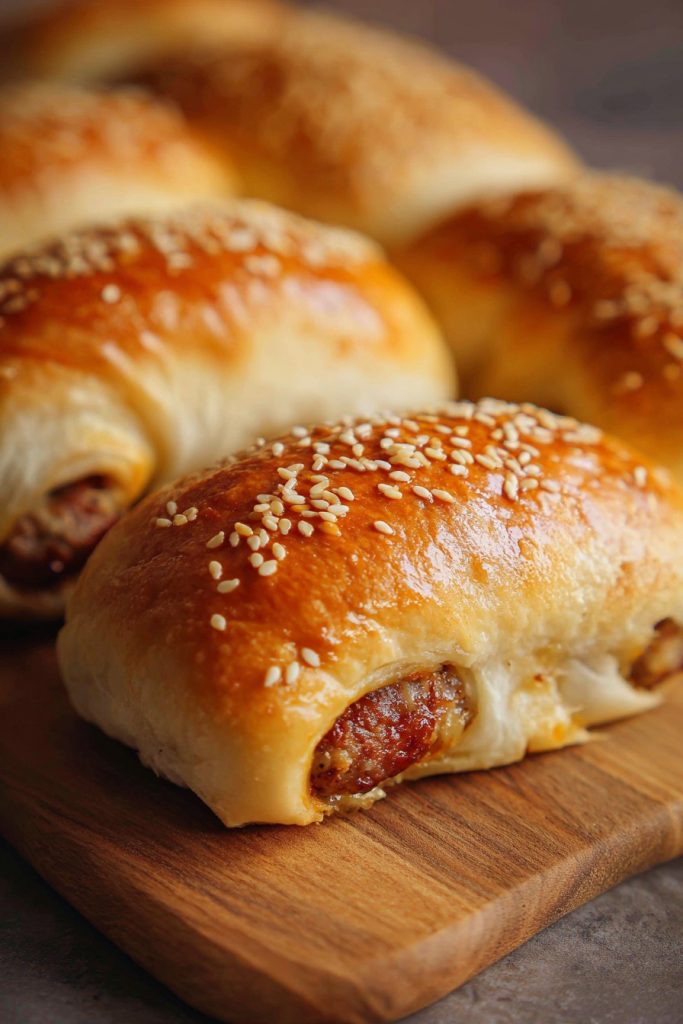Zesty flavors meet soft bread in these homemade sausage buns. Zero fuss required for this crowd-pleasing recipe that delivers professional results with simple ingredients. These buns offer the perfect balance of savory sausage encased in pillowy dough.
Why This Recipe Works
- The dough uses a combination of all-purpose flour and bread flour, creating a structure that’s strong enough to hold the filling while remaining tender and soft after baking
- Pre-cooking the sausage ensures it’s fully cooked and allows excess fat to drain, preventing soggy bottoms and ensuring food safety without overbaking the bread
- An egg wash applied before baking gives the buns their characteristic golden-brown shine and helps any toppings like sesame seeds adhere properly to the surface
- The two-stage rising process develops flavor complexity in the dough while creating the light, airy texture that makes these buns so enjoyable to eat
- Using instant yeast eliminates the need for proofing in water first, making the process more straightforward and reducing the risk of failed activation
Ingredients
- 3 cups all-purpose flour, measured by spooning into cup and leveling
- 1 cup bread flour, measured by spooning into cup and leveling
- 1 packet instant yeast (2 1/4 teaspoons)
- 2 tablespoons granulated sugar
- 1 1/4 teaspoons fine sea salt
- 1 cup whole milk, warmed to 110°F
- 1 large egg, at room temperature
- 3 tablespoons unsalted butter, softened
- 12 pork breakfast sausage links, approximately 4 ounces total
- 1 egg beaten with 1 tablespoon water for egg wash
- 2 tablespoons sesame seeds for topping
Equipment Needed
- Stand mixer with dough hook attachment
- Large mixing bowl
- Digital kitchen scale
- Instant-read thermometer
- Baking sheet
- Parchment paper
- Rolling pin
- Pastry brush
- Wire cooling rack
Instructions

Prepare the Dough
Combine 3 cups all-purpose flour, 1 cup bread flour, 1 packet instant yeast, 2 tablespoons granulated sugar, and 1 1/4 teaspoons fine sea salt in the bowl of a stand mixer. Use the paddle attachment to mix these dry ingredients on low speed for 30 seconds until evenly distributed. Warm 1 cup whole milk to exactly 110°F using an instant-read thermometer – this temperature activates the yeast without killing it. Add the warm milk, 1 large room temperature egg, and 3 tablespoons softened unsalted butter to the dry ingredients. Switch to the dough hook attachment and mix on medium speed for 8 minutes until the dough becomes smooth, elastic, and pulls away from the sides of the bowl. The dough should pass the windowpane test: when you stretch a small piece between your fingers, it should form a thin, translucent membrane without tearing. If the dough remains sticky, add additional all-purpose flour 1 tablespoon at a time, mixing for 30 seconds between additions. Tip: Proper dough temperature is crucial – if your kitchen is cooler than 70°F, place the mixing bowl in a slightly warmed oven (turned off) to help the yeast activate.
First Rise and Sausage Preparation
Transfer the completed dough to a lightly oiled large bowl, turning it once to coat all surfaces with oil. Cover the bowl tightly with plastic wrap or a damp kitchen towel. Place the bowl in a warm, draft-free area such as an oven with the light on or on top of the refrigerator. Allow the dough to rise for 1 to 1 1/2 hours until doubled in size. While the dough rises, prepare 12 pork breakfast sausage links by cooking them in a skillet over medium heat for 8-10 minutes, turning frequently until browned on all sides and cooked through to an internal temperature of 160°F. Transfer the cooked sausages to a paper towel-lined plate to drain excess grease and allow them to cool completely to room temperature. The sausages must be cool before wrapping to prevent them from cooking the dough from inside. Test the dough’s readiness by pressing two fingers about 1/2 inch into it – if the indentations remain, the dough has risen sufficiently.
Shape the Buns
Punch down the risen dough to release air bubbles and transfer it to a lightly floured surface. Divide the dough into 12 equal portions using a bench scraper or sharp knife, weighing each piece to ensure consistency – they should be approximately 2.5 ounces each. Working with one portion at a time, use a rolling pin to flatten each piece into a 5×3 inch oval shape about 1/4 inch thick. Place one cooled sausage link horizontally across the center of each dough oval. Bring the long sides of the dough up and over the sausage, pinching the seam firmly together to seal completely. Roll the sealed bun gently between your hands to create a smooth, even cylinder shape. Place the shaped buns seam-side down on a parchment-lined baking sheet, spacing them about 2 inches apart to allow for expansion during the second rise and baking.
Second Rise and Preheat
Cover the shaped buns loosely with plastic wrap or a clean kitchen towel and return them to a warm, draft-free location for the second rise. This proofing period should take 45-60 minutes until the buns have visibly puffed up and nearly doubled in size. To test readiness, gently press the side of a bun with your fingertip – the indentation should spring back slowly but not completely disappear. Meanwhile, position one oven rack in the center position and preheat your oven to 375°F about 20 minutes before the second rise completes. Proper oven temperature is essential for optimal rise and browning, so use an oven thermometer to verify accuracy if possible. Tip: For extra soft buns, create steam in your oven by placing a small pan of hot water on the bottom rack during preheating.
Bake to Perfection
Prepare the egg wash by beating 1 egg with 1 tablespoon water until smooth and uniform. Using a pastry brush, gently apply a thin, even layer of egg wash to the top and sides of each risen bun, being careful not to deflate them. Sprinkle 2 tablespoons sesame seeds evenly over the egg-washed surfaces. Place the baking sheet in the preheated 375°F oven and bake for 18-22 minutes until the buns develop a deep golden-brown color. Rotate the baking sheet halfway through baking to ensure even browning. Check for doneness by tapping the bottom of a bun – it should sound hollow when fully baked. The internal temperature should reach 190-200°F when measured with an instant-read thermometer. Immediately transfer the baked buns to a wire cooling rack using a spatula. Allow them to cool for at least 15 minutes before serving to allow the crumb structure to set properly. Tip: For extra shine, brush the warm buns with melted butter immediately after removing them from the oven.
Tips and Tricks
For optimal dough development, consider using the autolyse method by mixing the flours and water only, letting them rest for 30 minutes before adding the remaining ingredients. This hydrates the flour fully and develops gluten structure with less kneading. When measuring flour, avoid scooping directly from the bag as this compacts the flour and leads to dense buns. Instead, spoon flour into your measuring cup and level with a straight edge. For consistent sizing, use a digital kitchen scale to portion your dough – each piece should weigh between 2.4 and 2.6 ounces for uniform baking. If your kitchen is particularly dry, cover your rising dough with a damp cloth instead of plastic wrap to prevent surface drying. For enhanced flavor complexity, try an overnight cold fermentation by refrigerating the shaped buns after the second rise and baking them the next morning – this develops deeper yeast flavors. When applying egg wash, use a soft-bristled brush and apply in one direction to avoid tearing the delicate risen dough. For those without a stand mixer, the dough can be kneaded by hand for 12-15 minutes on a lightly floured surface until it passes the windowpane test. If your sausages are particularly fatty, consider baking them instead of pan-frying at 400°F for 12-15 minutes to render more fat without added oil. For perfect browning every time, monitor your oven’s hot spots and rotate your baking sheet accordingly – most ovens have warmer areas in the back. Store completely cooled buns in an airtight container at room temperature for up to 3 days, or freeze for up to 3 months by wrapping individually in plastic wrap and placing in a freezer bag. To refresh day-old buns, wrap in aluminum foil and warm in a 300°F oven for 8-10 minutes, or microwave for 15-20 seconds wrapped in a damp paper towel.
Recipe Variations
- Cheese-Stuffed Version: Incorporate 4 ounces of shredded cheddar or mozzarella cheese into the dough during the final minute of mixing, or place a small cube of cheese alongside each sausage before wrapping. The melted cheese creates a creamy center that complements the savory sausage. For best results, use low-moisture cheeses that won’t make the dough soggy during baking.
- Whole Grain Adaptation: Replace 1 cup of all-purpose flour with whole wheat flour and add 2 tablespoons of additional milk to account for whole wheat’s higher absorption rate. The nutty flavor of whole wheat pairs wonderfully with sausage, though the buns will be slightly denser. Soaking the whole wheat flour in the milk for 30 minutes before mixing improves the texture.
- Spicy Korean-Style: Use Korean sausage or mix 1 teaspoon gochugaru (Korean red pepper flakes), 1 minced garlic clove, and 1 tablespoon soy sauce into regular sausage before cooking. Brush the baked buns with a mixture of 1 tablespoon honey, 1 teaspoon gochujang, and 1 teaspoon sesame oil for a sweet-spicy glaze that adds complexity to the flavor profile.
- Vegetarian Alternative: Replace sausage with seasoned vegetarian sausage links or create a filling from 1 cup cooked lentils mixed with 2 tablespoons breadcrumbs, 1 teaspoon smoked paprika, and 1/2 teaspoon fennel seeds. The lentil mixture should be cooled completely before wrapping to maintain the dough’s structure during rising and baking.
- Sweet Breakfast Version: Increase the sugar in the dough to 1/4 cup and add 1 teaspoon cinnamon. Use chicken-apple sausage and brush the baked buns with a simple glaze made from 1/2 cup powdered sugar and 2 tablespoons milk. This variation works particularly well for brunch occasions or as a breakfast pastry alternative.
Frequently Asked Questions
Can I make these sausage buns ahead of time?
Yes, sausage buns are excellent for advance preparation. After shaping the buns, instead of the second rise at room temperature, cover them tightly with plastic wrap and refrigerate for up to 24 hours. When ready to bake, remove from refrigerator, apply egg wash and toppings, and allow to sit at room temperature for 30 minutes while the oven preheats. Bake as directed, adding 2-3 minutes to the baking time if the buns are still cool from refrigeration. This method actually enhances flavor development through slow fermentation.
What’s the difference between using all-purpose flour versus bread flour?
Bread flour contains more protein (12-14%) compared to all-purpose flour (10-12%), which creates stronger gluten networks ideal for structured breads. In this recipe, using 1 cup bread flour with 3 cups all-purpose flour provides the perfect balance – enough structure to hold the sausage filling while maintaining a tender crumb. If you only have all-purpose flour, the buns will still work but may spread slightly more during baking. For best results with all-purpose only, reduce liquid by 1-2 tablespoons.
My dough isn’t rising properly – what could be wrong?
Several factors affect dough rising: yeast may be expired, liquid temperature could be too hot (above 130°F kills yeast) or too cold (below 95°F slows activation), or your rising environment might be too cool. Ensure your yeast is fresh by testing it in warm water with a pinch of sugar – it should foam within 10 minutes. The ideal rising temperature is 75-85°F. If your kitchen is cooler, place the dough in an oven with the light on or near a warm appliance. Also avoid using metal bowls for rising as they conduct cold more than glass or ceramic.
Can I freeze unbaked sausage buns?
Yes, freezing unbaked buns works well. After shaping and the second rise, place the baking sheet in the freezer until the buns are firm, then transfer to freezer bags. When ready to bake, place frozen buns on a parchment-lined sheet, cover, and thaw in the refrigerator overnight or at room temperature for 2-3 hours. Apply egg wash and bake as directed, adding 3-5 minutes to the baking time. This method preserves the freshness better than freezing baked buns, though both are acceptable.
Why did my buns split open during baking?
Splitting typically occurs for three reasons: the dough was rolled too thin around the sausage, the seam wasn’t properly sealed, or the second rise was insufficient. Ensure your dough ovals are large enough to fully encase the sausage with about 1/2 inch overlap for sealing. Pinch the seam firmly and roll gently to seal completely. Adequate second rise allows the dough to expand gradually rather than bursting suddenly in the oven’s heat. If splitting persists, try scoring the top of each bun with a sharp knife before baking to control expansion.
Summary
These homemade sausage buns combine soft, fluffy dough with savory sausage in a versatile format perfect for breakfast, snacks, or parties. With clear instructions and helpful techniques, even beginner bakers can achieve professional-quality results. The recipe offers multiple variations to suit different tastes and dietary preferences.
Sausage Buns
6
servings30
minutes20
minutesIngredients
Instructions
- 1 Combine flours, yeast, sugar, and salt in stand mixer. Add warm milk, egg, and butter. Mix with dough hook for 8 minutes until smooth and elastic.
- 2 Transfer dough to oiled bowl, cover, and rise for 1-1.5 hours until doubled. Cook sausages until 160°F internal temperature, then cool completely.
- 3 Divide dough into 12 pieces. Roll each into 5x3 inch oval, place sausage in center, seal seam, and shape into cylinder.
- 4 Place buns on parchment-lined sheet, cover, and rise 45-60 minutes until puffed. Preheat oven to 375°F.
- 5 Brush buns with egg wash, sprinkle with sesame seeds. Bake 18-22 minutes at 375°F until golden brown. Cool 15 minutes before serving.



